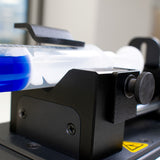Calibration of Peristaltic Pumps
Calibration of peristaltic pumps is far more than a simple adjustment of flow rates. Instead, it requires an understanding of the complex interactions between the mechanical system, materials properties, and fluid dynamics. The calibration processes are designed to account for variations in tube properties, mechanical tolerances in the systems design and manufacture, and environmental conditions that can change the properties of the fluids being pumped. Proper calibration of your peristaltic pump ensures not only accurate flow rates but can improve tube lifetime, improve consistency in fluid delivery, and improve process control.
Why is Calibration Needed?
The mechanical action of the rollers compressing the tubing creates complex stress patterns, leading to an immediate deformation of the tubing anda time dependent viscoelastic response. This viscoelastic behavior can vary with temperature, fluid viscosity, pumping rate, and lifetime of the tubing itself. All mean calibration is essential to ensure that the fluid you are working with is being accurately delivered.
Calibration processes can vary depending upon the pump design. For examples, variable occlusion systems have additional layer of calibration that is needed: the occlusion force. This force impacts both the recovery of the tubing from the elastic deformation and the total stresses experienced by the tubing. By calibrating the occlusion force it is possible to minimize the stresses and damage to the tubing to improve its lifetime and reduce the need for calibration over time.
Initial Calibration Process
An initial calibration process establishes a baseline performance under controlled conditions, this process begins by preparing the system. If new tubing is being installed in the pump, it is essential to precondition it so that the tubing can reach a steady state of response. We recommend at least 30 minutes to an hour to ensure the tubing has undergone a sufficient number of compression cycles and reached a consistent temperature.
During the initial calibration process, the relationship between pump speed and actual fluid delivery rate is determined. This relationship can vary from the theoretical linear response due to several factors:
- Tube recovery time: After compression by the roller, the tube does not instantly return to its original shape. There is a response time based upon the viscoelastic properties of the material and the viscosity of the pumped fluid. This results in a reduction in the actual dispensed volume that is pump rate dependent.
- Mechanical tolerances: Small variations in the tube diameter and the occlusion distance can result in variations in flow rate of the system. This can result in either higher or lower dispense rates.
The typical method for calibration uses a reference fluid. This is often water; however, it is best practise to use a liquid with a viscosity similar to the one you will use with the system. The reference liquid is pumped into a beaker and a target volume is set for the dispense rate. The weight of the dispensed liquid is measured and, from this, the volume can be calculated. A correction factor can then be determined for that pump rate. This is repeated across the whole range of pumping speeds and a response curve is made for the system.
Temperature Compensation
Once an initial calibration is performed at a fixed temperature, back pressure, and fluid viscosity, a range of different correction factors can be determined for environmental and processing conditions to better optimize the peristaltic pumps dispense rates. The most important of these is the temperature compensation because it has the largest impact on dispense rates. Temperature can impact the actual internal diameter of the tubing and the recovery rate of the tubing from deformation.
A simple linear temperature compensation response, Qt is the flow rate at a given temperature Qref is the flow rate at a reference temperature, T is the temperature, and α is a temperature correction factor.
The process of determining a compensation factor is like the initial calibration process. The process is repeated for a range of potential system operating temperatures.
The response of temperature is mostly linear when operated around room temperature. As the temperature is raised significantly above this (40 to 60°C based upon tubing material), the response may behave non-linearly and a polynomial temperature correction factor may be needed:
Viscosity Compensation
Viscosity of the pumped fluid is something that can vary from experiment to experiment, if you are working with materials that exhibit a wide range of viscosities it is always important to ensure your peristaltic pump can be calibrated against different viscosities. Higher viscosity solutions typically result in a slower response of the tubing to deformation recovery. In addition, high viscosities can result in non-slip conditions at the tubes surface to fail facilitating back flow through the tubing.
Viscosity is a complex factor to compensate for especially when working at high viscosities or with non-Newtonian fluids. Non-Newtonian fluids will exhibit varying viscosities as a function of pump rate, further adding to the complexity of compensating for viscosity. Non-Newtonian fluids can exhibit shear thinning, shear thickening, and thixotropic behaviors which make modelling the response of these fluids difficult. Generally, it is recommended to perform a full initial calibration for a specific non-Newtonian fluid because dynamic correction for these types of materials is difficult and can result in erroneous correction factors being applied.
Learn More
Peristaltic pumps are a type of positive displacement pump that use the progressive compression and relaxation of a flexible tube to move fluid along. These pumps mirror the biological process called peristalsis.
Read more... Displacement vs Pressure Controlled Syringe Pump
Displacement vs Pressure Controlled Syringe Pump
When selecting a syringe pump for your application, one key factor to consider is the pump's operating principle. Do you need a pressure or displacement syringe pump?
Read more...